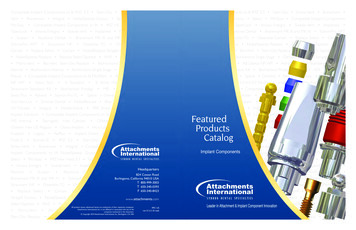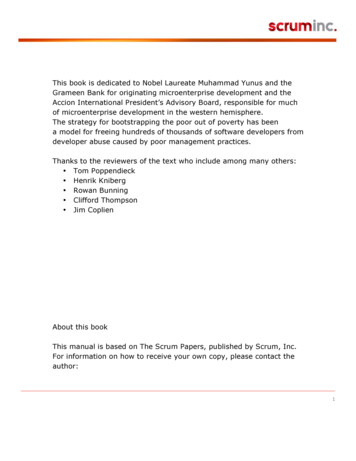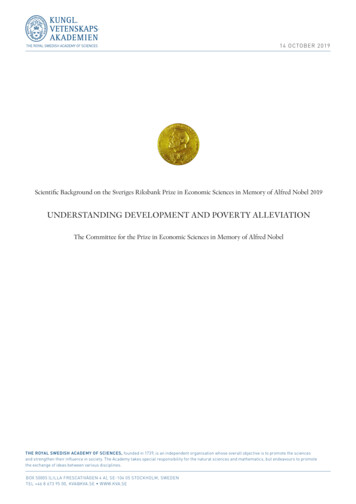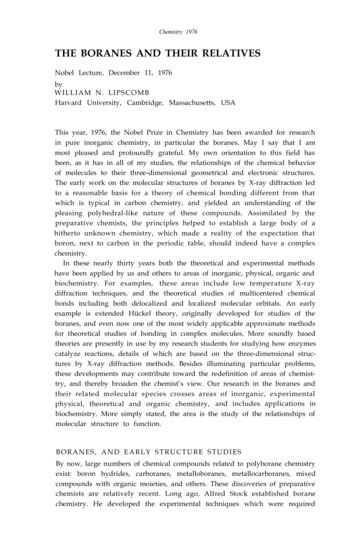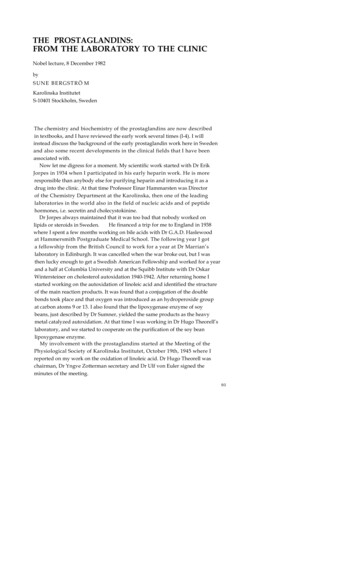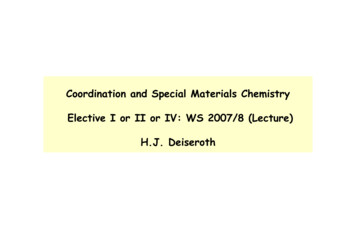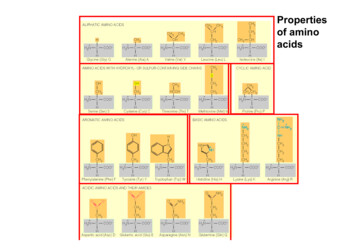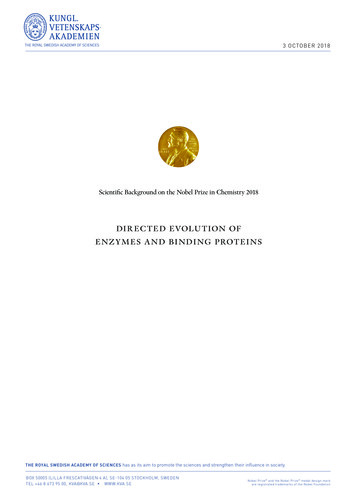
Transcription
3 OCTOBE R 2018Scientific Background on the Nobel Prize in Chemistry 2018DI R EC T E D EVOLU T ION OFEN Z Y M ES A N D B I N D I N G P RO T E I N STHE ROYAL SWEDISH ACADEMY OF SCIENCES has as its aim to promote the sciences and strengthen their influence in society.BOX 50005 (LILLA FRESCATIVÄGEN 4 A), SE-104 05 STOCKHOLM, SWEDENTEL 46 8 673 95 00, KVA@KVA.SE WWW.KVA.SENobel Prize and the Nobel Prize medal design markare registrated trademarks of the Nobel Foundation
The Royal Swedish Academy of Sciences has decided to award the Nobel Prize for Chemistry2018 with one half to Frances H Arnold “for the directed evolution of enzymes”, and the otherhalf jointly to George P Smith and Sir Gregory P Winter "for the phage display of peptidesand antibodies”.IntroductionNatural evolution of enzymes has existed since the emergence of life on Earth. Genes havemutated and proteins have evolved to improve the fitness of an organism to tackle conditions innew environments. For thousands of years, humans have been breeding animals and plantsthrough the selection of organisms with desired properties. For most of this time without evenknowing they were doing it, humans evolved and optimised enzymes and binding proteins overmany generations.Directed evolution of enzymes and bindingproteins is a manmade procedure built onmolecular insights, which moves theevolution process into the laboratory andspeeds it up. The procedure relies onintended variation of protein sequences at adefined level of randomness. This is coupledto engineered screening and selectionstrategies. Directed evolution is an iterativeprocedure which involves the identification ofa starting state protein, diversification of itsFigure 1. Evolution towards directed evolutiongene, an expression and screening strategy,re-diversification, re-screening, and so onuntil a satisfactory performance level in terms of enzymatic activity, binding affinity orspecificity is reached.Directed evolution of enzymes and binding proteins has become a widely used strategy inacademic research as well as in the chemical and pharmaceutical industries. Directed evolutionof enzymes tailors them to operate in new reaction conditions, optimises their catalytic activitytowards new substrates, and makes them catalyse new chemical reactions. Directed evolution ofenzymes has widely expanded the repertoire of useful biocatalysts. The evolved enzymes offerefficient and environmentally-friendly alternatives to metals and organic catalysts in chemicaland biotechnical industries.Directed evolution of binding proteins is an efficient way to identify variants with high affinityand selectivity for a given target, and to map the sequence requirements for high-affinity andhigh selectivity protein interactions. Directed evolution of human antibodies leads to usefultherapeutics.1 (24)
Directed evolution of enzymes and binding proteins – in theoryIn 1984, Manfred Eigen published a theoretical paper outlining a possible work flow for directedevolution of enzymes (Figure 2, ref 1). Eigen noted that such optimisation becomes aninteresting challenge because the genotype and the phenotype are dependent on differentmolecules. He reasoned that finding rare improved variants in large libraries would be hard ifnot impossible. Instead he proposed the use of smaller libraries and several generations ofmutagenesis and screening as a procedure that would more likely lead forward. Eigen predictedthat it would be possible to construct a stepwise iterative “evolutionary machine” to produceoptimised enzymes.Another theoretical prediction is found in a patent (2) that describes evolution of bindingproteins through iterative diversification of libraries between selection rounds. Directedevolution of enzymes was also briefly introduced as a possibility in an abstract of a moreclassical protein-engineering study of enzyme optimisation (3).Figure 2. Extract from Eigen’s theoretical proposal of directed evolution (1).Directed evolution of enzymes – in practiseOne decade after Eigen’s theoretical work (1), the first experimental work appeared thatdescribed successful implementation of directed evolution of enzymes in a laboratory setting toimprove enzyme function and versatility (4). Frances H Arnold reported the directedevolution of subtilisin E to obtain an enzyme variant which was active in a highly unnatural(denaturing) environment, i.e. at high concentrations of the polar organic solventdimethylformamide (DMF). After four sequential rounds of mutagenesis and screening in thepresence of DMF, an enzyme variant with 256-fold higher activity than the wild-type enzyme in60% (v/v) DMF was created (4,5).In the seminal paper (4), Arnold had mastered the whole work flow for directed evolution ofenzymes, a methodology relying on several parts: 1) identification of a suitable starting enzymefor the chosen task, 2) DNA-sequence library construction to cover well-chosen subsets of2 (24)
sequence space, 3) identification of selection criteria that will lead to enhanced or new functionsand methods for selection of optimised enzyme variants, 4) re-diversification of the genes tocreate new DNA-sequence libraries around the sequences from the first selection to cover newsubsets of sequence space, 5) setup of selection criteria with increased stringency, and so on foras many rounds as needed to reach the target level of enzyme performance. Each of these fivesteps has since been further developed and optimised over the years in the Arnold lab andseveral other labs.In addition to a first set of four combined single mutations, the first work (4) used error-pronePCR to create and re-diversify DNA-sequence libraries through three rounds of randommutagenesis and screening to evolve subtilisin E. The selection criterion was hydrolysis of themilk protein casein. Active enzyme variants created visible halos on agar plates with casein.Enzymes secreted by bacterial colonies were thus transferred to agar plates containing bothDMF and casein, to enable identification of the most active enzyme variants in the presence ofthe organic solvent. Plasmid DNA was isolated from clones secreting an enzyme variant thatproduced a halo larger than those surrounding the parent enzyme, and subjected to furtherrounds of mutagenesis.The directed evolution of subtilisin E to improve its activity in a polar organic solvent was abenchmark achievement that opened the field of directed evolution of enzymes. This workbecame the starting point for continued technical development of the methodology for directedevolution. The field expanded towards improving and reshaping enzymes for numerouschemical reactions, old and new, leading to applications of importance for research in organicsynthesis, as well as for the chemical and pharmaceutical industry and beyond.Molecular insights guide library designIt is not possible to randomise every position in an enzyme, the typical size of which is 200-300amino acid residues or more. Indeed, only a small fraction of the amino acid positions can bevaried if the aim is a library with full sequence coverage. The reason is simple combinatorialmathematics and the quickly growing number of variants relative to the number of clones thatcan be handled in any laboratory setting, or even using the joint capacity of all laboratories inthe world. Still, a wealth of studies makes it clear that mutations in and nearby the active site aswell as more distant substitutions on the enzyme surface may contribute to optimised catalyticactivity. Arnold and co-workers have shown by many examples that library design must bebased on molecular insight and knowledge-based choices of which amino-acid positions to vary,combined with some element of added randomness, e.g. through error-prone PCR.A prominent early contributor to the development and implementation of methodology fordirected evolution was the late William (Pim) Stemmer (†2013). Stemmer introduced a DNArecombination strategy termed “DNA shuffling” to the evolution of enzymes. This was anefficient way to propagate beneficial mutations while increasing the size of a DNA library3 (24)
through random fragmentation and re-assembly of genes (6,7). He showed that the use of DNAshuffling, i.e. recombination of DNA from similar genes from several organisms, introducesmore variation than many other methods and can thus improve the chances to reach asubstantial activity increase in the evolved variants. In a proof-of-principle study Stemmer andco-workers set out to increase the activity of the enzyme β-lactamase (an enzyme responsible forantibiotic resistance); three cycles of DNA shuffling and screening on plates with successivelyhigher concentration of the antibiotic cefotaxime led to evolution of an enzyme with significantlyincreased activity (6,7). Gene shuffling had been reported as a means to increase variation andimprove antibody affinity for a target, sometimes called affinity maturation, and provided earlyexamples of directed evolution of binding proteins (8-10). In these cases the shuffled genesegments corresponded to light chains (10) or to the variable loops of heavy and light chains ofimmunoglobulins (8,9).Figure 3. The work flow for the directed evolution of enzymes.4 (24)
DNA shuffling, staggered extension process (StEP) and other methods for library generationwere further developed in Arnold’s and Stemmer’s laboratories for use in the directed evolutionof enzymes during the second half of the 1990s (11-26). Since the end of last century, theprogressively decreasing costs for de novo synthesis of genes with degenerate codons, or fullydesigned DNA libraries, have opened a new path towards efficient and affordable production ofsequence libraries with tailored diversity.Selection criteria and screening techniquesThe selection criteria and screening techniques must be adapted for each enzyme optimisationendeavour. Selection may be coupled to a cellular survival function; for example, the desiredenzymatic activity may detoxify a compound which otherwise inhibits growth. Selection mayalso be coupled to a spectroscopic enzyme assay or other means of optical or ocular probing forenhanced activity.When using directed evolution to improve enzyme activity under non-native conditions, such aselevated temperature or high concentration of a toxic or denaturing substance or organicsolvent, the conditions may have to be introduced stepwise with gradually increasing stringencyof selection pressure. This ensures that the enzyme template in each round has at least somerudimentary starting activity under the conditions used in that round. Stepwise increase of thestress factor, with intervening diversification between selection rounds, makes it possible toderive successively more effective and more tolerant enzymes or enzymes with new catalyticproperties. Selection may be performed on agar plates (4-6), using a filter-lift assay (4) or usingflow cytometry (27,28). Dan Tawfik showed that directed evolution of enzymes can be set upwithout use of living cells, for example, using in vitro compartmentalization in water-in-oilemulsion droplets containing ribosomes and library mRNA (29).New reaction conditionsThe early applications of directed evolution of enzymes aimed to optimise the stability and theperformance under new reaction conditions such as high fractions of organic solvents (4),further rounds of directed evolution were added to reach a 471-fold activity increase over wildtype (30). Another example from the Arnold lab concerned the optimisation of a paranitrobenzyl esterase for activity in the presence of a (31).Many methods exist for increasing the thermostability of enzymes and other proteins. Whendirected evolution of enzymes is used with an aim to increase their thermal stability, theevolutionary process may be set up as interleaved heat treatment and activity assays, oralternatively the activity assays may be performed at elevated temperature. In one study, thethermostability of Bacillus subtilis p-nitrobenzyl esterase was increased by over 14 C (increasein Tm) after six generations of random mutagenesis, recombination via DNA shuffling, and5 (24)
screening with interleaved heat treatment and activity assays (32). This work showed that it ispossible to improve the thermal stability of an enzyme without compromising its catalyticactivity at lower temperatures, if both properties are constrained. If not, the evolution of oneproperty may come at the cost of the other, regardless of whether the two properties areinversely correlated or not correlated at all (32). Nature usually provides organisms adapted tocold or warm environments with two different enzymes having optimal catalytic properties atlow or at high temperatures, respectively. Arnold showed that directed evolution can produce asingle enzyme with high catalytic activity at both high and low temperatures (32-35). Anotherdirected evolution strategy relied on structural information in the form of crystallographic Bfactors, a measure of which regions are more or less ordered in a crystallised protein. Byfocusing the library of mutations to the 10 positions with highest B-factors, a large increase inenzyme stability was achieved (36).In addition to deriving improved and novel biocatalysts, directed evolution studies contribute toour general understanding of natural protein evolution process and determinants of enzymeaction, although the selection pressures operate over totally different time scales, populationsizes, mutation rates, strength of selection, etc. Arnold and others have shown the importancefor protein evolution of factors such as thermostability (37,38), the relative effects of randommutations and recombination (39), the importance of neutral drift for the evolution of proteinfunction (40,41) and correlations between the rates of protein expression and evolution (42).Choice of starting stateArnold and co-workers have repeatedly shown that it is possible to evolve enzymes to improvetheir activity under new conditions in terms of solution composition, temperature, etc., and tochange their catalytic activity towards new substrates and reactions. This is possible as long asthe enzyme that is chosen as a starting point has at least some low level of activity for theintended reaction, i.e. some level of catalytic promiscuity (Figure 4, reviewed in e.g. 43-46). Aninactive scaffold is not a suitable choice; directed evolution requires some low level of activity.Even a very low activity level towards the intended reaction provides a starting state to optimisethrough evolution. Often just a few mutations are required to boost up the new activity.If an enzyme has a low level of activity for an intended reaction, but much higher activity for anatural one, it may be fruitful to first lower the natural activity before starting the directedevolution efforts towards the new intended reaction.New chemical reactionsAs a recent example of this latter strategy, the activity of tryptophan synthetase from Pyrococcusfuriosus was first reduced by 95% through the removal of the non-catalytic domains of theenzyme. The isolated catalytic domain was subject to three rounds of directed evolution tointroduce new catalytic activities towards synthesis of tryptophan analogues (47-51).6 (24)
Figure 4. A: A starting point with no activity for the intended reaction is useless since no sequencevariations (red arrows) create the new reactivity. B: A promiscuous enzyme with at least low activity forthe intended reaction is a suitable staring point. Some combinations of random mutations may improvethe new reactivity (black arrow). The first variant (1) serves as a starting state for sequential rounds ofvariation and screening (2) (3) (4) for improved variants. Only a small number of cycles and aretypically needed to boost up the new reactivity.In a series of studies, Arnold and co-workers changed the activity of cytochrome P450 tocatalyse a set of reactions for which no specific enzyme was previously available, for example,cyclopropanation. Cytochrome P450BM3 has a catalytic promiscuity and an ability to catalyse,with very low efficiency, the cyclopropanation of styrene by ethyl-diazoacetate (EDA). Muchmore specific and efficient enzymes were evolved and only a small fraction (0.2%) of the aminoacids in the enzyme needed to be changed to optimise the new catalytic activity (52-54). Thisincluded a change of the iron-ligating residue from Cys to Ser or His, leading to a shift in thecharacteristic 450-nm Soret peak in the absorbance spectrum of the enzyme to 411 nm.Therefore, the evolved enzymes were called cytochrome P411.Other examples of reactions for which no natural enzymes have evolved are nitrene transferreactions. In one case, Arnold and co-workers started from a cytochrome P411 variant performsazide reduction about 100 times more efficiently than nitrene transfer to sulphide. Usingdirected evolution they produced an enzyme variant that instead efficiently promotes thedesired nitrene transfer process (55). There are several other examples of directed evolution ofenzymes for carbene and nitrene transfer reactions (see for example 56,57).Reactions with aliphatic and aromatic CH bonds are another tractable goal. Using directedevolution of cytochrome P450 monooxygenase, an enzyme was created that catalysesintermolecular amination of benzylic C–H bonds. The biocatalyst is enantioselective and lasts7 (24)
for up to 1,300 turnovers, thereby providing an efficient biocatalyst for synthesis of valuablebenzylic amines (58).Other examples of evolution towards new reactions include generation of enzymes that catalysearsenate detoxification (14), the production of highly strained carbocycles (59), and theswitching of an enzyme from a galactosidase to a fucosidase (15).Figure 5. An evolved biocatalyst forcyclopropanation. The cytochromeP411 variant of cytochrome P450 (ref.52) with the protein backbone shownas ribbon representation and sidechains as sticks. Side-chains that weremutated in engineered variants areshown in red.Metabolic pathwaysA strength of the directed evolution methodology is the ability to co-evolve enzymes inbiosynthetic pathways. In one example Arnold and co-workers evolved a multi-enzyme pathwayfor carotenoid production in E. coli (60). Her lab also showed how whole-cell biocatalysts can bedeveloped for the production of valuable chemicals by using directed evolution to enable theproduction of L-methionine in E. coli (61).BiofuelsOne challenge for mankind is finding suitable replacements or supplements for fossil fuels,which can be produced in a sustainable and environmentally-friendly manner. Here, one seeksto produce alcohols from short-chain alkanes (62) and a leading candidate biofuel is 2methylpropan-1-ol (isobutanol). Isobutanol can be produced using a biosynthetic pathway inrecombinant Escherichia coli. Two enzymes in the pathway, however, require reducednicotinamide adenine dinucleotide phosphate (NADPH) as a cofactor, while glycolysis, thenormal metabolism during growth of E. coli produces reduced nicotinamide adeninedinucleotide (NADH). To resolve this obstacle, Arnold and co-workers used directed evolutionto alter the co-factor dependence of the enzymes so they can instead rely on NADH, making theenzymes and thereby the organism suitable for biofuel production (63).8 (24)
New chemical bondsCarbon-silicon bonds are common in human-made chemicals but absent in biology. Nature hasnot evolved enzymes that catalyse the formation of carbon-silicon bonds. However, directedevolution can be used as a strategy to ensure that such chemistry invented by humans can alsobe conducted by help of enzymes. Arnold and co-workers noted that haem proteins can catalysenon-natural carbene-insertion reactions. After screening a number of haem proteins fromvarious organisms, they decided to use cytochrome c from Rhodothermus marinus as a startingpoint. This protein catalyses the formation of carbon-silicon bonds with low efficiency, but with97% enantiomeric excess (ee; 64). A small library of variants was screened during heattreatment and in catalytic activity assays, and the best candidate was subjected to furthermutagenesis and screening. The result of this work is an enzyme that catalyses silicon-carbonbond formation 40 times better than the starting enzyme and with 99% ee (64). The evolvedenzyme had 15 times higher turnover number than the best non-enzyme catalyst known for thesame reaction. This example shows that it is possible to expand the scope of enzyme-catalysedreactions in terms of which kinds of bonds are formed by the engineered enzyme.Other examples of bonds and reactions not catalysed by any enzyme found in nature, but forwhich directed evolution was used to create efficient enzymes, are carbon-borane bonds (65)and enantio-selective intramolecular C-H amination (66).Enantio-selectivityDirected evolution is an efficient way to improve the enantio-selectivity of enzymes, i.e.,enhancing their performance in asymmetric catalysis. The evolved enzymes are used in theproduction of chiral substances with high enantiomer purity. An early example of directedevolution with the aim of improving the enantio-selectivity of an enzyme was reported byMatcham and Bowen concerning transaminases in the catalysis of chiral amine production (67).This work started with an enzyme with low level of S-selectivity (65% ee) in the conversion ofthe ketone β-tetralone to aminotetraline, the corresponding amine. A library of mutants wasgenerated and screened for enhanced activity on the S-isomer but not the R-isomer. The resultwas a biocatalyst that produced the S-aminotetraline with greatly enhanced selectivity (94% ee),which was further improved by additional rounds of mutagenesis and screening (67). ManfredReetz and co-workers reported another early example that has led to improved enantioselectivity of lipases in ester hydrolysis (68). Through directed evolution via four cycles ofrandom mutagenesis, the selectivity factor of a bacterial lipase from Pseudomonas aeruginosawas first increased from 1.1 to 11 (68) and then to 35 after further diversification of the library(69). Other early examples are found in (70-73).Directed evolution in organic synthesis and industryDirected evolution quickly made its way from the academic setting to industrial applications(74-77). Enzymes developed using directed evolution are used in industry in the production of9 (24)
biofuels, materials, bulk and fine chemicals, detergents, consumer products, laboratory reagentsand pharmaceuticals, as well as intermediates for the pharmaceutical industry. Several of theenzymes developed in the Arnold lab are used in industry. Many companies have their ownscientific teams applying directed evolution strategies to improve catalysts or protein-basedtherapeutics in terms of stability, activity, specificity or other properties. Specific examples ofevolved enzymes and products are taste enhancers, drugs against diabetes and vascular plaques,as well as lipid-lowering pharmaceuticals. Some enzymes produced by directed evolution aremade on very large scale. This includes lipases used in detergents. Industrial chemicals aremade in enormous quantities with the help of biocatalysts produced by directed evolution.A green alternativeDirected evolution provides enzymes with unique specificity, thereby offering environmentallyfriendly biocatalysts. Enzymes developed using directed evolution have replaced harshindustrial processes with milder biotechnology that does not require toxic metals or largeamounts of organic solvent. Industrial use of enzymes developed using directed evolution have,for example, replaced chemical catalysts in asymmetric synthesis and provide a greenalternative that leads to lower consumption of organic solvents and lower amounts of sideproducts and waste.Directed evolution in protein designDirected evolution seeks to alter the activities of already-existing enzymes based on molecularinsights combined with a large element of randomness. Orthogonal to directed evolution is therational design of proteins. Protein design is based on ab initio or empirical calculations andaims to design proteins from scratch. However, in the protein design field, it is widelyacknowledged that in order to reach an acceptable level of fitness, for example, in terms ofbinding affinity and specificity, it is at our current level of knowledge necessary to add directedevolution as a final optimisation step (see for example refs. 78-80).Summary and outlookDirected evolution of enzymes has become a highly efficient protocol for development ofbiocatalysts with high specificity, limited side reactions and tolerance of diverse reactionconditions. Directed evolution is a versatile and efficient path towards optimised enzymes andenzymes with novel functions. A main conclusion emerging from directed evolution research isthat enzymes can indeed be tuned to catalyse new reactions, and to reactions very different fromthe ones catalysed by nature’s own enzymes. There is ample room for optimisation andredirection of enzyme function in terms of reactivity, substrate specificity and chemicalreactions, as well as tolerance to various reaction conditions. We are probably very far from thelimit of which reactions enzymes can catalyse – there is plenty of room for further discovery.10 (24)
Phage display of peptides and antibodiesDirected evolution of binding proteins is facilitated by a physical coupling between phenotype(high affinity high selectivity binding protein) and genotype (DNA sequence). This is providedby phage display.Phage display of peptidesPhage display represents a major technology breakthrough and was developed by George PSmith (81). The DNA that codes for a specific protein member of the library is packaged insidethe phage in such a way that the phage presents the protein on its surface. This simplifiesscreening based on binding to receptors. This also simplifies the identification and amplificationof phages displaying the best binding proteins. Infection by the phages of E. coli andmultiplication in the host produces an enriched library after each round of selection. It is alsopossible to re-diversify the phage library between the selection rounds.In a seminal paper, Smith showed that a peptide could be inserted in a loop of protein III, aminor coat protein on the surface of fusion phage, and that the displayed peptide retainedinteraction with its target (81). In this work, the displayed peptide was a 57-residue fragment ofa restriction endonuclease. Using a single round of affinity purification versus antiserum to theendonuclease, Smith showed that phages presenting the endonuclease peptide inserted into coatprotein III of their surface could be enriched 1,000-fold over other phages. He outlined a wayforward towards much greater enrichment, which might be achieved by using a sequence ofaffinity purification rounds. He also predicted that it would be possible to isolate clones from alibrary of random inserts in a phage vector using affinity purification with an antibody as thebait (81).In another publication, from 1988 (82), Parmley and Smith introduced several technicalimprovements to the phage display technology, for example, by moving the location of thedisplayed peptide within protein III. This was motivated by the fact that protein III mediatesinfection of E. coli by binding to its F pilus. Fully functional protein III is thus essential forpropagation of the phage. Smith introduced the term “biopanning” for affinity purification ofphages displaying high affinity peptides from a background of lower affinity ones, usingstreptavidin-coated Petri dishes to which biotinylated target was coupled. This offered an easydevice for capture, washing and elution in the affinity-purification procedure. Smith showed thefeasibility of his improved approach by achieving 108-fold enrichment of phages displaying apeptide representing the epitope of an anti-β-galactosidase antibody using affinity purificationtowards its target (82).11 (24)
Smith also proposed that phage display of peptides might aid in vaccine development (81). Thisinspired studies where peptides from the malaria parasite Plasmodium falciparum weredisplayed on the surface of filamentous phage and found to be active as antigens (83,84).Figure 6. Selection of high-affinity binding proteins from phage display libraries. An initial library of peptide orprotein variants displayed on protein III at the tip of the phage (upper left) is added to a target protein (blueyellow) immobilized on a solid support, here magnetic beads (red). After extensive washing to remove weaklybound phages (lower right), the best binding variants are eluted (e.g. using acid) and used to infect E coli toproduce an amplified library enrich in high-affinity members for a next round of affinity purification. Theprocedure can be repeated as many times as needed to obtain the desired level of selection.Phage display of peptide librariesIn his 1985 paper (81), Smith predicted that it would be possible to isolate clones from a libraryof random inserts in a phage vector. In 1988 (82), he wrote that the expression of a largenumber of peptides with random sequences on the phage surface might be useful for finding theepitopes recognised by antibodies. He reasoned that such technology might reveal the epitope ofalmost any antibody, since many antibodies recognise short linear segments of five-six aminoacid residues. The framework for producing phage display libraries for selection of bindingpeptides was thus developed in the Smith laboratory, but also immediately picked up by othergroups. A number of publications appeared almost simultaneously in the early 1990s, describingthe expression and display of combinatorial sequence libraries of short peptides on the surfaceof filamentous phage, and
2018 with one half to Frances H Arnold "for the directed evolution of enzymes", and the other half jointly to George P Smith and Sir Gregory P Winter "for the phage display of peptides and antibodies". . (10) or to the variable loops heavy and light chains ofof immunoglobulins (8,9). Figure 3. The work flow for the directed evolution of .


